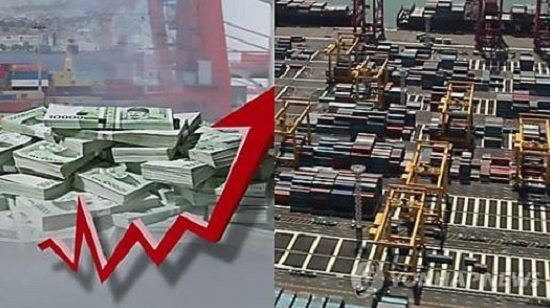Korea ups economic growth forecast to 3% for 2017
Moon administration releases economic policy blueprint, puts positive spin on strong exports and extra budget effect
By Korea HeraldPublished : July 25, 2017 - 17:06
South Korea on Tuesday raised its economic growth forecast for this year to 3 percent, pledging to create inclusive growth with its four major economic policy pillars of income-led growth, job creation, a fair economy and innovative growth.
The Ministry of Strategy and Finance on Tuesday drew up the Moon Jae-in government’s economic policy directions, in which it raised the nation’s growth forecast from 2.6 percent to 3 percent on the back of an uptrend in exports and an incoming fiscal injection. The corresponding forecast for next year will also likely be 3 percent, according to the ministry.
But the government, unlike the two former conservative administrations, refrained from pinning down detailed figures for mid- and long-term economic expansion, vowing to prioritize fair distribution of wealth over quantitative growth.
The Ministry of Strategy and Finance on Tuesday drew up the Moon Jae-in government’s economic policy directions, in which it raised the nation’s growth forecast from 2.6 percent to 3 percent on the back of an uptrend in exports and an incoming fiscal injection. The corresponding forecast for next year will also likely be 3 percent, according to the ministry.
But the government, unlike the two former conservative administrations, refrained from pinning down detailed figures for mid- and long-term economic expansion, vowing to prioritize fair distribution of wealth over quantitative growth.

“There may be controversies, but we believe that our potential growth rate stands around 3 percent,” Assistant Finance Vice Minister Lee Chan-woo said in a press briefing.
“Should we improve our production capacities, a 3 percent growth may be achieved this year.”
The 3 percent mark had been initially suggested in June last year but the target had been lowered by 0.4 percentage point in the face of an interest rate hike and domestic social divides.
Should South Korea achieve the renewed target growth rate this year, it is to retrieve growth of over 3 percent for the first time in three years since 2014, when it recorded 3.3 percent.
The upward revision in the growth forecast came in the wake of a number of recovery signs, most of them pivoting on strong outbound shipments.
The country’s exports have remained in surplus for eight straight months as of June, riding on active trade and rising oil prices.
Exports during the first half of this year totaled at $279.4 billion, up 15.5 percentage points from the same period last year. The government’s former forecast for this year’s exports increase was 2.9 percentage points on-year.
Another positive factor was the swearing-in of President Moon Jae-in in early May, which ended the political uncertainties caused by the suspension and ouster of former President Park Geun-hye.
The Bank of Korea changed its forecast from 2.6 percent to 2.8 percent earlier this month. Moody’s and the Asian Development Bank also made an upward change from the former 2.5 percent to 2.8 percent and 2.7 percent respectively.
Of the reasons for the ministry’s optimistic turn was the anticipated stimulus effect of the supplementary budget bill, which recently passed the legislature after months of partisan brawls.
The 11.3 trillion won ($10.2 billion) extra budget was initiated upon President Moon Jae-in’s stern vow to place top priority on job creating and his consequent call for a corresponding budget. The government’s plan is to execute some 70 percent of the amount by early October so as to expedite the economic boosting effects.
“We expect that the extra budget will pull up the growth rate by some 0.2 percentage point,” Assistant Finance Vice Minister Lee Chan-woo said in a press briefing.
“Once we improve our economy through an income-led growth system, we will thus safely reach the 3 percent target.”
The income-led growth paradigm is a key plan in President Moon’s progressive economic blueprint, which sees equal opportunities and fair distribution as core concepts of economic growth.
Refusing to be motivated by external results and figures, the new administration vowed to break away from the conventional growth-centered economic vision.
“The target growth rate has no actual significance. What matters is to achieve growth in a good and fair manner,” an official of the presidential office Cheong Wa Dae told reporters earlier this month, urging for a new perspective on growth.
“Even with a growth rate in the 2 percent range, we should be able to deal with the core challenges in our society.”
The ministry’s updated forecast, however, still remains higher than that by most of the international organizations and private institutions, and thus is leading to concerns that the Moon administration may not meet its self-suggested standards.
Possible challenges to hold down the nation’s economic path include a slowdown in the construction sector, following the government’s incoming regulations on the real estate market.
Also, the heavy household debt which is amounting to nearly 1,400 trillion won is another pressure for the liberal government which previously pledged to minimize tax burdens for the public.
By Bae Hyun-jung (tellme@heraldcorp.com)
-
Articles by Korea Herald








![[KH Explains] How should Korea adjust its trade defenses against Chinese EVs?](http://res.heraldm.com/phpwas/restmb_idxmake.php?idx=644&simg=/content/image/2024/04/15/20240415050562_0.jpg&u=20240415144419)











![[Today’s K-pop] Stray Kids to return soon: report](http://res.heraldm.com/phpwas/restmb_idxmake.php?idx=642&simg=/content/image/2024/04/16/20240416050713_0.jpg&u=)